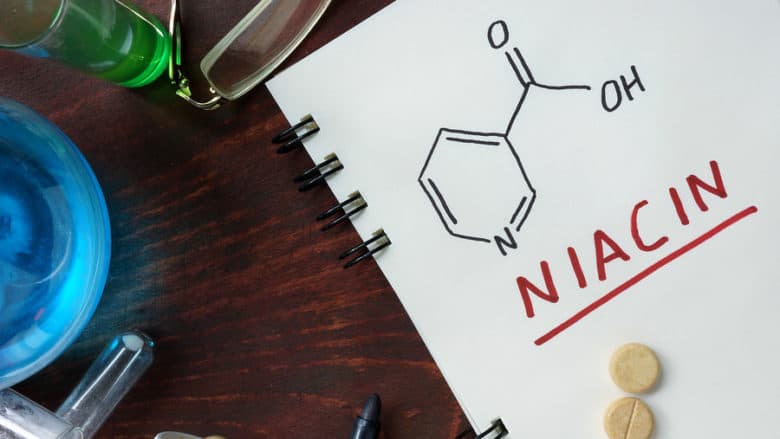
Why know about niacin benefits? Here’s one reason:
Harriet had to stop the medication she was taking for high cholesterol (Crestor). She felt like she had the flu with continual joint pain in her shoulders, hips, knees, and hands. She felt exhausted.
She was shocked when she read, “There is no question that niacin (but not niacinamide) can significantly improve cholesterol profile, reducing levels of total and LDL (“bad”) cholesterol and raising HDL (“good”) cholesterol,” in a ConsumerLab.com report.
Then she went on the FDA website where she found an “FDA Alert” warning of serious muscle damage and possible kidney failure in patients taking Crestor as well as other statin drugs.
After talking to her doctor, Harriet now takes niacin instead of statin drugs for her cholesterol. Her LDH (bad) cholesterol is in the normal range at 149 and her HDL (good) cholesterol level is rising… both good indicators for the prevention of heart disease!
About Niacin
Niacin (also called nicotinic acid) and its derivative niacinamide (also called nicotinamide or nicotinic acid amide) are the most common forms of the water-soluble vitamin B3.
They’re essentially identical when taken in low doses for nutritional needs, but may differ in effects when taken in high doses.
Another less common form of niacin called inositol hexaniacinate has special properties of its own.
Niacin benefits show up in its role as an essential nutrient for the body and as a drug when used in high doses to treat health conditions.
It supports natural healing and health.
Niacin Benefits as an Essential Nutrient
- Acts as an important cofactor needed for the proper functioning of over 50 enzymes. Enzymes are proteins needed for all the chemical reaction that make life possible. No vitamin, hormone, or mineral can exert its beneficial effects in the body without the help of enzymes.
- Helps the body produce energy and metabolize fat and cholesterol.
- Helps make sex hormones and other important signal molecules.
- Is a structural component of Glucose Tolerance Factor (GTF) that potentiates insulin. Niacin improves its ability to bind to cell surface receptors.
Niacin Benefits as a Drug
Niacin decreases the risk of heart attack by significantly improving lipid (fat) blood levels.
This niacin benefit has been known since the 1950’s!
It can reduce LDL (bad) cholesterol levels by as much as 30 percent.
It also lowers triglycerides levels and raises HDL (good) cholesterol levels by as much as 33 percent according to studies reported by the Berkley Wellness Alerts; Ray Strand, MD, nutritional medicine expert; and ConsumerLab.com.
High dose niacin actually outperforms statin drugs in its ability to raise the good HDL levels of cholesterol. It also does not cause muscle disorders as statin drugs may do.
Here are other potential niacin benefits reported in ConsumerLab.com’s review of studies.
- Niacinamide may help blood sugar control for diabetics.
- Niacinamide may decrease symptoms of osteoarthritis according to preliminary evidence.
- Topical niacinamide may help decrease signs of skin aging improving elasticity and appearance as well as treat rosacea (a red-face acne-like skin condition).
- The inositol form of niacin may help intermittent claudication (decreased blood flow to the legs) and Raynaud’s disease (a circulation problem of the fingers, toes, tips of ears, or nose).
- There’s weak evidence that niacin may help in the treatment of bursitis, cataracts, HIV infection, schizophrenia, and tardive dyskinesia (involuntary, repetitive movements).
How do you get niacin benefits?
Your body can make niacin from the common amino acid tryptophan. You can also get it from many healthy foods such as meats (particularly turkey), fish, legumes, seeds, green leafy vegetables, whole grains, and milk.
The recommended daily allowance (RDA) is 20 mg. Ray Strand, MD in Bionutrition recommends supplementing your diet with taking 30 to 75 mg daily.
When used as a drug for the treatment of health conditions, much higher dosages of 1,000 to 4,500 mg are required. These higher doses can cause liver inflammation making medical supervision essential.
Special Considerations
Common niacin side effects are skin flushing and headache. You can reduce these symptoms by gradually increasing the dose over several weeks or dividing the dose into 2 or 3 smaller doses during the day.
Further, taking the inositol hexaniacinate form may cause less flushing than plain niacin, report experts at ConsumerLab.com. Taking an aspirin along with niacin may help decrease these symptoms too.
Some doctors use slow-release niacin to help, but this form appears to be more likely to cause liver inflammation according to ConsumerLab.com.
It is important to have medical supervision when using niacin to treat a health condition, as there are many specifics to consider, such as dosage, timing, and prevention of side effects.
Key Points
Niacin benefits show up in many ways, from helping your body function properly to treating heath conditions. It has a strong track record for improving blood lipid levels.
Look for the recommended dosage (at least 20 mg) of niacin in an optimal cellular nutrition supplement and for health conditions ask your health provider how niacin benefits might help you!
Sources and Resources
Berkley Wellness Alerts at http://www.berkeleywellnessalerts.com/alerts/dietary_supplements/Niacin-for-Cholesterol119-1.html?ET=bwalerts:e197:44914a:&st;=email.
ConsumerLab.com at http://www.consumerlab.com/tnp.asp?chunkiid=21769.
FDA US Food and Drug Administration, “Information for Healthcare Professionals: Crestor (Rosuvastatin Calcium),” FDA Alert (03/2005) at http://www.fda.gov/Drugs/DrugSafety/PostmarketDrugSafetyInformationforPatientsandProviders/ucm124906.htm.
Ray D. Strand, Bionutrition (Rapid City, SD: Health Concepts, 2009).
